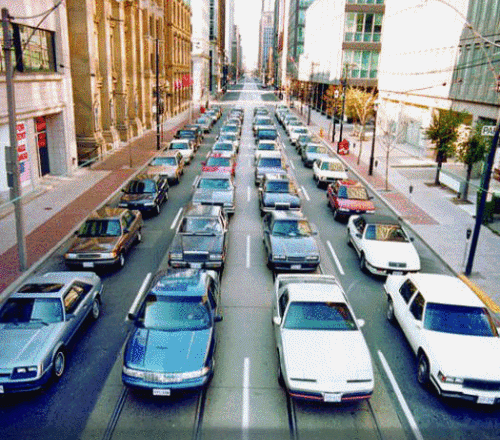Today TTI had released its latest edition of the popular product – Urban Mobility Report (2012). The 2012 edition introduced for the first time, a way to measure that degree of unreliability in planning a trip, as part of the annual Urban Mobility Report (UMR). The press release explains it succintly:
The Planning Time Index (PTI), a measure of travel reliability, illustrates the amount of extra time needed to arrive on time for higher priority events, such as an airline departure, just-in-time shipments, medical appointments or especially important social commitments. If the PTI for a particular trip is 3.00, a traveler would allow 60 minutes for a trip that typically takes 20 minutes when few cars are on the road. Allowing for a PTI of 3.00 would ensure on-time arrival 19 out of 20 times.
Access the whole report (PDF) by clicking the cover photo of the report below.

TTI’s 2012 Urban Mobility Report
As one would expect, the reactions for the report was mixed – both positive and negative from the transportation community. That said, here are some highlights from the 2012 UMR:
Congestion costs are increasing. The congestion “invoice” for the cost of extra time and fuel in 498 urban areas was (all values in constant 2011 dollars):
- In 2011 – $121 billion; In 2000 – $94 billion; In 1982 – $24 billion
Congestion wastes a massive amount of time, fuel and money. In 2011:
- 5.5 billion hours of extra time (equivalent to the time businesses and individuals spend a year filing their taxes).
- 2.9 billion gallons of wasted fuel (enough to fill four New Orleans Superdomes).
- $121 billion of delay and fuel cost (the negative effect of uncertain or longer delivery times, missed meetings, business relocations and other congestion-related effects are not included) ($121 billion is equivalent to the lost productivity and direct medical expenses of 12 average flu seasons).
- 56 billion pounds of additional carbon dioxide (CO2) greenhouse gas released into the atmosphere during urban congested conditions (equivalent to the liftoff weight of over 12,400 Space Shuttles with all fuel tanks full).
- 22% ($27 billion) of the delay cost was the effect of congestion on truck operations; this does not include any value for the goods being transported in the trucks.
- The cost to the average commuter was $818 in 2011 compared to an inflation-adjusted $342 in 1982.

English: Traffic congestion on southbound Interstate 95 in Baltimore, Maryland, near milepost 50. (Photo credit: Wikipedia)
Congestion affects people who travel during the peak period. The average commuter:
- Spent an extra 38 hours traveling in 2011, up from 16 hours in 1982.
- Wasted 19 gallons of fuel in 2011 – a week’s worth of fuel for the average U.S. driver – up from 8 gallons in 1982.
- In areas with over three million persons, commuters experienced an average of 52 hours of delay in 2011.
- Suffered 6 hours of congested road conditions on the average weekday in areas over 3 million population.
- Fridays are the worst days to travel. The combination of work, school, leisure and other trips mean that urban residents earn their weekend after suffering over 20 percent more delay hours than on Mondays.
- And if all that isn’t bad enough, folks making important trips had to plan for approximately three times as much travel time as in light traffic conditions in order to account for the effects of unexpected crashes, bad weather, special events and other irregular congestion causes.
Congestion is also a problem at other hours.
-
Approximately 37 percent of total delay occurs in the midday and overnight (outside of the peak hours) times of day when travelers and shippers expect free-flow travel. Many manufacturing processes depend on a free-flow trip for efficient production and congested networks interfere with those operations.
























